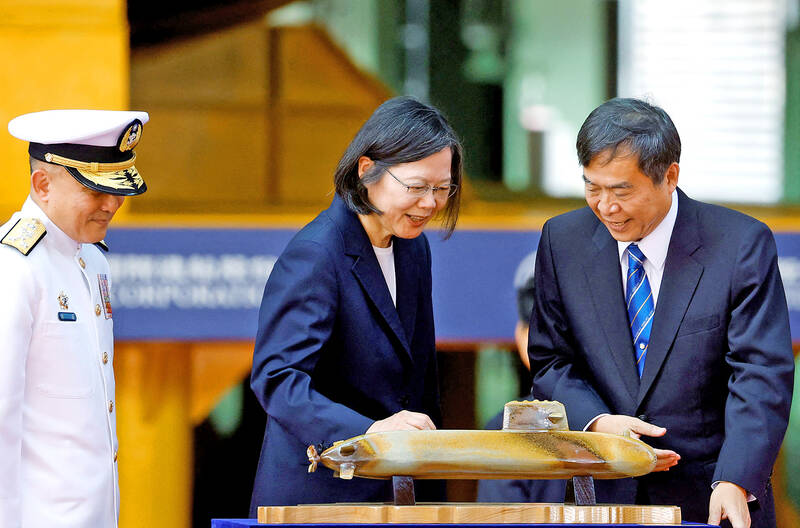President Tsai Ing-wen (蔡英文) yesterday presided over the launch of the nation’s first domestically made submarine, called Hai Kun (海鯤), or Narwhal, or at a ceremony in Kaohsiung, calling the event a crucial moment in Taiwan’s mission to produce domestic subs and achieve “defense autonomy.”
The ceremony was held at a CSBC Corp, Taiwan (台灣國際造船) shipyard, the contractor for the nation’s Indigenous Defense Submarine (IDS) project.
“Today will go down in history,” Tsai said in her remarks.

Photo: EPA-EFE / Presidential Office
Building an IDS used to be considered “mission impossible,” but it is now a reality, she added.
Saying that submarines are crucial in the navy’s efforts to develop asymmetric combat capabilities and other key strategies, Tsai hailed the occasion as a landmark in the nation’s bid to achieve “defense autonomy.”
The IDS prototype has the pennant number “711” and an X-shaped rudder, instead of a cross-shaped rudder seen on previous models, which according to CSBC Corp, Taiwan chairman Cheng Wen-lon (鄭文隆) gives it an edge over Taiwan’s other submarines in active service.

Photo: Carlos Garcia Rawlins, Reuters
Asked why the ship was named Hai Kun, Navy Command said that Taiwan was once called “Kun Island.”
Kun is the name of a “gigantic” fish in the first chapter of Zhuangzi titled “Free and easy wandering” (逍遙遊), it said.
Kun also connotes “stealth” and “hard to detect” motions, it said
The submarine would be able to move far and wide, and thus provide naval deterrence to better protect the nation, it said.
The number 711 symbolizes “cross-generation” and “superb excellence,” it added.
Also in attendance at the ceremony were IDS program convener Huang Shu-kuang (黃曙光), American Institute in Taiwan Director Sandra Oudkirk, Minister of National Defense Chiu Kuo-cheng (邱國正) and Kaohsiung Mayor Chen Chi-mai (陳其邁).
Only the bow of the submarine was exposed at the ceremony, with the torpedo tubes and other critical components covered with a national flag.
Huang on Monday said that after the launch ceremony, the IDS prototype is to undergo a harbor acceptance test on Sunday, followed by a sea acceptance test, and hopefully would be delivered to the navy before the end of next year.
The IDS program aims to build another submarine by 2027.
Both submarines are to be deployed to defend the waters around Taiwan, and the area from Suao Township (蘇澳) in Yilan County to near Yonaguni Island in Japan’s Okinawa Prefecture, Huang said.
The building of domestic submarines means Taiwan’s navy will have three combat-ready submarines by 2025 and four by 2027, including two existing Chien Lung-class (Sword Dragon) submarines bought from the Netherlands in the 1980s.
Taiwan also has two World War II-vintage subs purchased from the US in the 1970s, which are now only used for training.

CROSS-STRAIT COLLABORATION: The new KMT chairwoman expressed interest in meeting the Chinese president from the start, but she’ll have to pay to get in Beijing allegedly agreed to let Chinese Nationalist Party (KMT) Chairwoman Cheng Li-wun (鄭麗文) meet with Chinese President Xi Jinping (習近平) around the Lunar New Year holiday next year on three conditions, including that the KMT block Taiwan’s arms purchases, a source said yesterday. Cheng has expressed interest in meeting Xi since she won the KMT’s chairmanship election in October. A source, speaking on condition of anonymity, said a consensus on a meeting was allegedly reached after two KMT vice chairmen visited China’s Taiwan Affairs Office Director Song Tao (宋濤) in China last month. Beijing allegedly gave the KMT three conditions it had to

STAYING ALERT: China this week deployed its largest maritime show of force to date in the region, prompting concern in Taipei and Tokyo, which Beijing has brushed off Deterring conflict over Taiwan is a priority, the White House said in its National Security Strategy published yesterday, which also called on Japan and South Korea to increase their defense spending to help protect the first island chain. Taiwan is strategically positioned between Northeast and Southeast Asia, and provides direct access to the second island chain, with one-third of global shipping passing through the South China Sea, the report said. Given the implications for the US economy, along with Taiwan’s dominance in semiconductors, “deterring a conflict over Taiwan, ideally by preserving military overmatch, is a priority,” it said. However, the strategy also reiterated

‘BALANCE OF POWER’: Hegseth said that the US did not want to ‘strangle’ China, but to ensure that none of Washington’s allies would be vulnerable to military aggression Washington has no intention of changing the “status quo” in the Taiwan Strait, US Secretary of Defense Pete Hegseth said on Saturday, adding that one of the US military’s main priorities is to deter China “through strength, not through confrontation.” Speaking at the annual Reagan National Defense Forum in Simi Valley, California, Hegseth outlined the US Department of Defense’s priorities under US President Donald Trump. “First, defending the US homeland and our hemisphere. Second, deterring China through strength, not confrontation. Third, increased burden sharing for us, allies and partners. And fourth, supercharging the US defense industrial base,” he said. US-China relations under

The Chien Feng IV (勁蜂, Mighty Hornet) loitering munition is on track to enter flight tests next month in connection with potential adoption by Taiwanese and US armed forces, a government source said yesterday. The kamikaze drone, which boasts a range of 1,000km, debuted at the Taipei Aerospace and Defense Technology Exhibition in September, the official said on condition of anonymity. The Chungshan Institute of Science and Technology and US-based Kratos Defense jointly developed the platform by leveraging the engine and airframe of the latter’s MQM-178 Firejet target drone, they said. The uncrewed aerial vehicle is designed to utilize an artificial intelligence computer